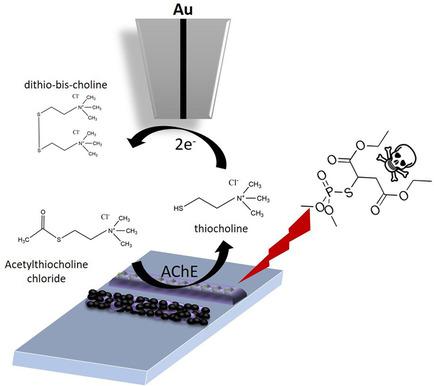当前位置:
X-MOL 学术
›
Electroanalysis
›
论文详情
Our official English website, www.x-mol.net, welcomes your feedback! (Note: you will need to create a separate account there.)
Stripe‐shaped Electrochemical Biosensor for Organophosphate Pesticide
Electroanalysis ( IF 3 ) Pub Date : 2018-09-21 , DOI: 10.1002/elan.201800406 Anna Celebanska 1 , Justyna Jedraszko 1, 2 , Adam Lesniewski 1 , Elena Jubete 3 , Marcin Opallo 1
Electroanalysis ( IF 3 ) Pub Date : 2018-09-21 , DOI: 10.1002/elan.201800406 Anna Celebanska 1 , Justyna Jedraszko 1, 2 , Adam Lesniewski 1 , Elena Jubete 3 , Marcin Opallo 1
Affiliation

|
Detection of organophosphate pesticides is indispensable to improve the quality of the water and therefore required by the European Union law. Here, we propose a novel architecture of a pesticide biosensor where the enzyme and the electrode are placed into neighboring zones in the stripe form. This separation permits to use the optimal conditions for their immobilization resulting in undisrupted mechanical stability of the biosensor. The enzyme, acetylcholinesterase, generates thiocholine which is further oxidized at the carbon nanoparticles film electrode, exhibiting high electrocatalytic activity. The whole device was tested as a biosensor for malaoxon employing a wild or recombinant acetylcholinesterase. The latter allowed for incubation time decrease down to 10 minutes and lowered the detection limit to 0.25 nM. Moreover, the encapsulated enzyme activity was visualised by a scanning electrochemical microscopy.
中文翻译:

用于有机磷农药的条形电化学生物传感器
检测有机磷酸盐农药对于改善水质必不可少,因此是欧盟法律所要求的。在这里,我们提出了一种农药生物传感器的新型结构,其中酶和电极以条状形式放置在相邻区域中。这种分离允许使用最佳条件进行固定,从而确保生物传感器的机械稳定性不受干扰。该酶乙酰胆碱酯酶产生硫代胆碱,该硫代胆碱在碳纳米颗粒薄膜电极上进一步被氧化,表现出高的电催化活性。使用野生或重组乙酰胆碱酯酶将整个装置作为马拉松的生物传感器进行了测试。后者允许孵育时间减少到10分钟,并将检测极限降低到0.25 nM。而且,
更新日期:2018-09-21
中文翻译:

用于有机磷农药的条形电化学生物传感器
检测有机磷酸盐农药对于改善水质必不可少,因此是欧盟法律所要求的。在这里,我们提出了一种农药生物传感器的新型结构,其中酶和电极以条状形式放置在相邻区域中。这种分离允许使用最佳条件进行固定,从而确保生物传感器的机械稳定性不受干扰。该酶乙酰胆碱酯酶产生硫代胆碱,该硫代胆碱在碳纳米颗粒薄膜电极上进一步被氧化,表现出高的电催化活性。使用野生或重组乙酰胆碱酯酶将整个装置作为马拉松的生物传感器进行了测试。后者允许孵育时间减少到10分钟,并将检测极限降低到0.25 nM。而且,



























 京公网安备 11010802027423号
京公网安备 11010802027423号